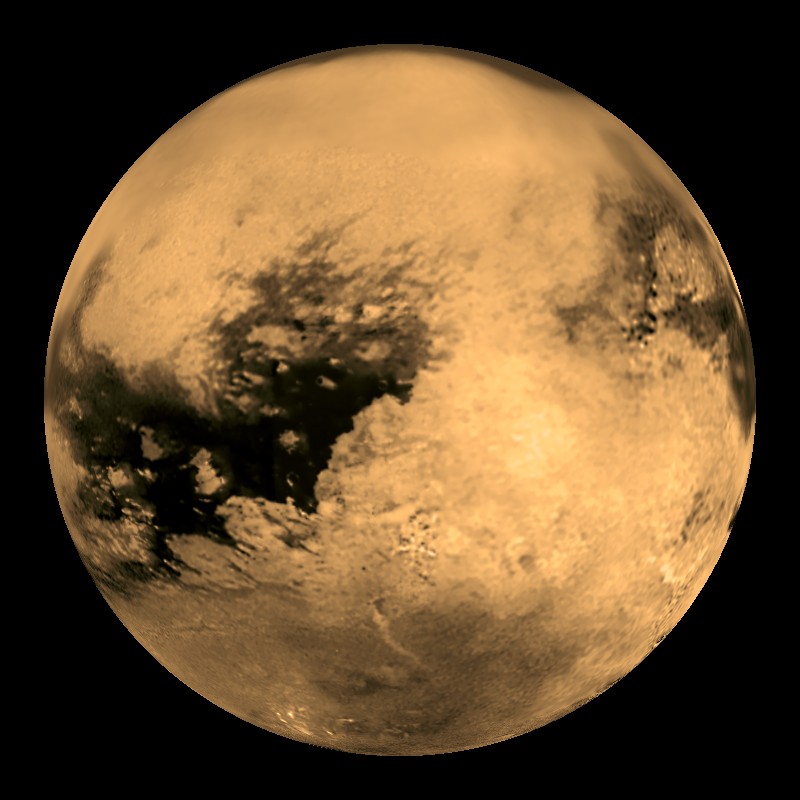Titan — Saturn’s Largest Moon
Description:
Long ago Titan was thought to be the largest moon in the solar system. New observations have revealed that Ganymede, one of Jupiter’s moons is even larger. Part of the reason for the mix-up is the thick, dense atmosphere that surrounds Titan, obstructing surface views. Titan, like Ganymede, is larger than both Mercury and Pluto. Until recently, a clear view of the surface was not available. In late 2004 the Cassini orbiter began to study Titan, and in January of 2005, the Huygens probe actually landed on the surface and began transmitting photographs of the surface.
 Titan (Saturn moon) color(4 mb)
Titan (Saturn moon) color(4 mb)MPEG4 - 800x800 - 70Mb
MPEG4 - 1024x1024 - 90Mb
MPEG4 - 1200x1200 - 100Mb
The atmosphere that encircles the moon is 50% greater than that around Earth. Composed of mainly nitrogen, similar to the Earth’s atmosphere, the atmosphere of Titan also has 6% argon and some methane along with many other organic compounds. This combination of gases, combined with sunlight, has created thick smog, similar to that seen over large cities. There are also clouds of ethane and methane obstructing the view of the surface. From the Huygens probe there is still much to discover, but some initial results show "lakes" and "rivers" that are currently dried up and are mostly crater-free surfaces. At least one of the lakes has been verified to have liquid ethane in at the present time. In 2009 the Cassini orbiter captured sunlight reflecting off surface, confirming the presence of liquid on Titan in the area covered with many large, lake-shaped basins. While it is not currently raining on the surface, there is some evidence of precipitation and erosion on the surface. There are three Titan datasets, one in color, the second in black and white, and the third is a black and white map with RADAR swaths from Cassini overlaid. The RADAR swaths show some of the seas, lakes and rivers of liquid hydrocarbons near the North Pole.
Notable Features:
- Relatively smooth surface with almost no craters
- Color variation across the planet (previously thought to be seas of methane, but that has been disproved. True origin has not been discovered.)
- At least one lake of liquid ethane is on the surface at the present time
Data Category
Major: Astronomy
Minor: Saturn
Keywords:
Solar System, moon
| Data Set Name | Titan (Saturn moon) color |
| Data Set Directory Name | titan/color |
| Data Set Source | Cassini |
| Data Set Developer | Fridger Schrempp |
| Visualization Developer | Steve Albers, NOAA/GSD |
| Audio | No |
| Download | FTP |
| Data Set Name | Titan (Saturn moon) black and white |
| Data Set Directory Name | titan/black_white |
| Data Set Source | Cassini Image details |
| Data Set Developer | NASA Cassini project; Steve Albers, NOAA/GSD |
| Visualization Developer | Steve Albers, NOAA/GSD |
| Audio | No |
| Download | FTP |
| Data Set Name | Titan with radar swaths |
| Data Set Directory Name | titan/radar_swaths |
| Data Set Source | Cassini RADAR Team |
| Data Set Developer | Cassini RADAR Team; Jason Perry, University of Arizona |
| Visualization Developer | Jason Perry, University of Arizona |
| Audio | No |
| Download | FTP |


 Titan (Saturn moon) black and white (4 mb)
Titan (Saturn moon) black and white (4 mb) Titan with radar swaths (1 mb)
Titan with radar swaths (1 mb)